Uttarakhand
| Uttarakhand उत्तराखण्ड उत्तराखण्डराज्यम् | ||||||||
|---|---|---|---|---|---|---|---|---|
| State | ||||||||
Uttarakhand montage: A Sunrise on Kalindi Mountains of the Himalayas Badrinath Temple in Chamoli district Snow-clad Auli, a ski destination & Raj Bhavan, Nainital A Bengal tiger walking in the Jim Corbett National Park Ganges river at Har Ki Pauri, Haridwar | ||||||||
| ||||||||
|
Nickname(s): Devbhumi देवभूमि | ||||||||
 Location of Uttarakhand (marked in red) in India | ||||||||
 Map of Uttarakhand | ||||||||
| Coordinates (Dehradun): 30°20′N 78°04′E / 30.33°N 78.06°ECoordinates: 30°20′N 78°04′E / 30.33°N 78.06°E | ||||||||
| Country |
| |||||||
| Region | North India | |||||||
| Established | 9 November 2000† | |||||||
| History |
Summary
| |||||||
| Capital | Dehradun †† | |||||||
| Largest city | Dehradun | |||||||
| Districts | 13 | |||||||
| Government | ||||||||
| • Body | Government of Uttarakhand | |||||||
| • Governor | Krishan Kant Paul | |||||||
| • Chief Minister | Harish Rawat (INC) | |||||||
| • Legislature | Unicameral (71 seats) ††† | |||||||
| • Parliamentary constituencies |
Rajya Sabha (3 seats) Lok Sabha (5 seats) | |||||||
| • High Court | Uttarakhand High Court | |||||||
| Area | ||||||||
| • Total | 53,483 km2 (20,650 sq mi) | |||||||
| Area rank | 19th | |||||||
| Population (2011) | ||||||||
| • Total |
10,116,752 5,154,178 ♂ 4,962,574 ♀ | |||||||
| • Rank | 20th | |||||||
| • Density | 189/km2 (490/sq mi) | |||||||
| • Density rank | 20th | |||||||
| Demonym | Uttarakhandi | |||||||
| Time zone | IST (UTC+05:30) | |||||||
| ISO 3166 code | IN-UT | |||||||
| Vehicle registration | UK 01—XX | |||||||
| HDI (2011) |
| |||||||
| HDI rank | 7th | |||||||
| Literacy (2011) |
79.63% 88.33% ♂ 70.70% ♀ | |||||||
| Sex ratio (2011) | 963 ♀/1000 ♂ | |||||||
| Languages spoken |
Hindi Garhwali Kumaoni Urdu Punjabi Jaunsari Bhoti | |||||||
| Official languages |
Hindi Sanskrit | |||||||
| Website | www.uk.gov.in | |||||||
|
†Formed by the Constitutional Amendment Act, 2000 by dividing Uttar Pradesh on November 9, 2000 ^†† Dehradun is the interim capital of the state. The new capital has not yet been chosen. | ||||||||
Uttarakhand (/ˌʊθəˈrɑːˌkʌnd/),[2] formerly Uttaranchal,[3] is a state in the northern part of India. It is often referred to as the Devbhumi (literally "Land of the Gods") due to the many Hindu temples and pilgrimage centres found throughout the state. Uttarakhand is known for its natural beauty of the Himalayas, the Bhabhar and the Terai. On 9 November 2000, this 27th state of the Republic of India was created from the Himalayan and adjoining northwestern districts of Uttar Pradesh.[4] It borders the Tibet Autonomous Region, China on the north; the Mahakali Zone of the Far-Western Region, Nepal on the east; and the Indian states of Uttar Pradesh to the south and Himachal Pradesh to the northwest. The state is divided into two divisions, Garhwal and Kumaon, with a total of 13 districts. The interim capital of Uttarakhand is Dehradun, the largest city in the region, which is a railhead. The High Court of the state is in Nainital.
Overview
Archaeological evidence support the existence of humans in the region since prehistoric times. The region formed a part of the Kuru and the Panchal kingdoms (mahajanpads) during the Vedic age of ancient India. Among the first major dynasties of Garhwal and Kumaon were the Kunindas in the 2nd century BCE who practised an early form of Shaivism. Ashokan edicts at Kalsi show the early presence of Buddhism in this region. During the medieval period the region was consolidated under the Kumaon Kingdom and Garhwal Kingdom. By 1803 the region fell to the Gorkha Empire of Nepal and with the conclusion of the Anglo-Nepalese War in 1816 most of modern Uttarakhand was ceded to the British as part of the Treaty of Sugauli. Although the erstwhile hill kingdoms of Garhwal and Kumaon were traditional rivals, the proximity of different neighbouring ethnic groups and the inseparable and complementary nature of their geography, economy, culture, language, and traditions created strong bonds between the two regions which further strengthened during the Uttarakhand movement for statehood in the 1990s.
The natives of the state are generally called Uttarakhandi or more specifically either Garhwali or Kumaoni depending on their place of origin. According to the 2011 Census of India, Uttarakhand has a population of 10,116,752, making it the 19th most populous state in India. A large portion of the population consists of Rajputs and Brahmins. About 85% of the population follow Hinduism. Islam is the largest minority religion in the state, followed by Sikhism, Christianity, Buddhism, and Jainism. Garhwali and Kumaoni along with other hilly dialects and sub-dialects are the main regional languages, whereas Hindi is the most widely spoken language. Uttarakhand is the only state in India with Sanskrit as one of its official languages.
Etymology
Uttarakhand's name is derived from the Sanskrit words Uttara (उत्तर) meaning North, and khaṇḍ (खण्ड) meaning Land, simply means Northern Land. The name finds mention in early Hindu scriptures as the combined region of "Kedarkhand" (present day Garhwal) and "Manaskhand" (present day Kumaon). Uttarakhand was also the ancient Puranic (पौराणिक) term for the central stretch of the Indian Himalayas.[5]
However, the region was given the name Uttaranchal by the Bharatiya Janata Party led central government and Uttar Pradesh state government when they started a new round of state reorganization in 1998. Chosen for its allegedly less separatist connotations, the name change generated enormous controversy among many activists for a separate state who saw it as a political act.[6] The name Uttarakhand remained popular in the region, even while Uttaranchal was promulgated through official usage.
In August 2006, India's Union Cabinet assented to the demands of the Uttaranchal state assembly and leading members of the Uttarakhand statehood movement to rename Uttaranchal state as Uttarakhand. Legislation to that effect was passed by the Uttarakhand Legislative Assembly in October 2006,[7] and the Union Cabinet brought in the bill in the winter session of Parliament. The bill was passed by Parliament and signed into law by then President A. P. J. Abdul Kalam in December 2006, and since 2007, the state is known as Uttarakhand.[8]
History
Ancient rock paintings, rock shelters, paleolithic stone tools (hundreds of thousands of years old), and megaliths provide evidence that the mountains of the region have been inhabited since prehistoric times. There are also archaeological remains which show the existence of early Vedic (c. 1500 BCE) practices in the area.[9] The Pauravas, Kushanas, Kunindas, Guptas, Gurjara-Pratihara, Katyuris, Raikas, Palas, Chands, Parmars or Panwars, Sikhs, and the British have ruled Uttarakhand in turns.[5] The region was originally settled by Kol people, an aboriginal people of the Austro-Asiatic physical type who were later joined by Indo-Aryan Khasas tribe hat arrived from the northwest by the Vedic period (1700–1100 BCE). At that time, present-day Uttarakhand also served as a habitat for Rishis and Sadhus. It is believed that the sage Vyasa scripted the Hindu epic Mahabharata in the state.[10] Among the first major dynasties of Garhwal and Kumaon were the Kunindas in the 2nd century BCE who practised an early form of Shaivism and traded salt with Western Tibet. It is evident from the Ashokan edict at Kalsi in Western Garhwal that Buddhism made inroads in this region. Folk shamanic practices deviating from Hindu orthodoxy also persisted here. However, Garhwal and Kumaon were restored to nominal Brahmanical rule due to the travails of Shankaracharya and the arrival of migrants from the plains. Between the 4th and 14th centuries, the Katyuri dynasty dominated lands of varying extent from the Katyur (modern day Baijnath) valley in Kumaon. The historically significant temples at Jageshwar are believed to have been built by the Katyuris and later remodelled by the Chands. Other peoples of the Tibeto-Burman group known as Kirata are thought to have settled in the northern highlands as well as in pockets throughout the region, and are believed to be ancestors of the modern day Bhotiya, Raji, Buksa, and Tharu people.[11]

By the medieval period, the region was consolidated under the Garhwal Kingdom in the west and the Kumaon Kingdom in the east. During this period, learning and new forms of painting (the Pahari school of art) developed.[12] Modern-day Garhwal was likewise unified under the rule of Parmars who, along with many Brahmins and Rajputs, also arrived from the plains.[13] In 1791 the expanding Gorkha Empire of Nepal overran Almora, the seat of the Kumaon Kingdom. In 1803 the Garhwal Kingdom also fell to the Gorkhas. With the conclusion of the Anglo-Nepalese War in 1816, the Garhwal Kingdom was re-established from a smaller region in Tehri, as the larger portion of Tehri, along with eastern Garhwal and Kumaon ceded to the British as part of the Treaty of Sugauli.
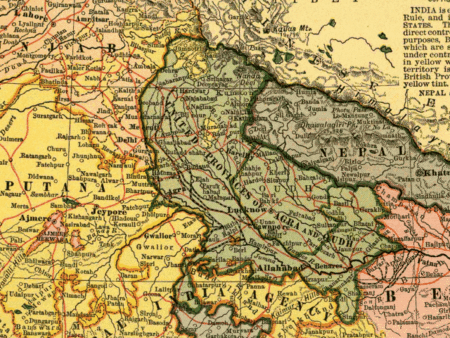
After India attained independence from the British, the Garhwal Kingdom was merged into the state of Uttar Pradesh, where Uttarakhand composed the Garhwal and Kumaon Divisions.[14] Until 1998, Uttarakhand was the name most commonly used to refer to the region, as various political groups, including the Uttarakhand Kranti Dal (Uttarakhand Revolutionary Party), began agitating for separate statehood under its banner. Although the erstwhile hill kingdoms of Garhwal and Kumaon were traditional rivals the inseparable and complementary nature of their geography, economy, culture, language, and traditions created strong bonds between the two regions.[15] These bonds formed the basis of the new political identity of Uttarakhand, which gained significant momentum in 1994, when demand for separate statehood achieved almost unanimous acceptance among both the local populace and national political parties.[16] The most notable incident during this period was the Rampur Tiraha firing case on the night of 1 October 1994, which led to a public uproar.[17] On 24 September 1998, the Uttar Pradesh Legislative Assembly passed the Uttar Pradesh Reorganisation Bill, which began the process of creating a new state.[18] Two years later the Parliament of India passed the Uttar Pradesh Reorganisation Act 2000, and thus, on 9 November 2000, Uttarakhand became the 27th state of the Republic of India.
| “ | "माटू हमरू, पाणी हमरू, हमरा ही छन यी बौण भी... पितरों न लगाई बौण, हमुनही त बचौण भी।" Soil ours, water ours, ours are these forests. Our forefathers raised them, it’s we who must protect them. - Old Chipko Song (Garhwali language)[19] |
” |
Uttarakhand is also well known for the mass agitation of the 1990s that led to the formation of the Chipko environmental movement[20] and other social movements. Though primarily a livelihood movement rather than a forest conservation movement, it went on to become a rallying point for many future environmentalists, environmental protests, and movements the world over and created a precedent for non-violent protest.[21] It stirred up the existing civil society in India, which began to address the issues of tribal and marginalized people. So much so that, a quarter of a century later, India Today mentioned the people behind the "forest satyagraha" of the Chipko movement as amongst "100 people who shaped India".[22] One of Chipko's most salient features was the mass participation of female villagers.[23] Both female and male activists played pivotal roles in the movement, including Chandi Prasad Bhatt, Sundarlal Bahuguna, and Ghanshyam Raturi, the popular Chipko poet.[24]
Geography
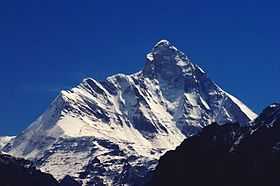
Uttarakhand has a total area of 53,483 km2,[25] of which 86% is mountainous and 65% is covered by forest.[25] Most of the northern part of the state is covered by high Himalayan peaks and glaciers. In the first half of the nineteenth century, the expanding development of Indian roads, railways and other physical infrastructure was giving rise to concerns over indiscriminate logging, particularly in the Himalaya. Two of the most important rivers in Hinduism originate in the region, the Ganges at Gangotri and the Yamuna at Yamunotri. These two along with Badrinath and Kedarnath form the Chota Char Dham, a holy pilgrimage for the Hindus. The state hosts the Bengal tiger in Jim Corbett National Park, the oldest national park of the Indian subcontinent. The Valley of Flowers, a Unesco World Heritage Site located in the upper expanses of Bhyundar Ganga near Joshimath in Gharwal region, is known for the variety and rarity of its flowers and plants.[26] [27] One who raised this was Sir Joseph Dalton Hooker, Director of the Royal Botanic Gardens, Kew, who visited the region. As a consequence, Lord Dalhousie issued the Indian Forest Charter in 1855, reversing the previous laissez-faire policy. The following Indian Forest Act of 1878 put Indian forestry on a solid scientific basis. A direct consequence was the founding of the Imperial Forest School at Dehradun by Dietrich Brandis in 1878. Renamed the 'Imperial Forest Research Institute' in 1906, it is now known as the Forest Research Institute (India). The model “Forest Circles” around Dehradun, used for training, demonstration and scientific measurements, had a lasting positive influence on the forests and ecology of the region. The Himalayan ecosystem provides habitat for many animals (including bharal, snow leopards, leopards and tigers), plants, and rare herbs. Two of India's largest rivers, the Ganges and the Yamuna, originate in the glaciers of Uttarakhand, where they are fed by myriad lakes, glacial melts and streams.[28]
Uttarakhand lies on the southern slope of the Himalaya range, and the climate and vegetation vary greatly with elevation, from glaciers at the highest elevations to subtropical forests at the lower elevations. The highest elevations are covered by ice and bare rock. Below them, between 3,000 and 5,000 metres (9,800 and 16,400 ft) are the western Himalayan alpine shrub and meadows. The temperate western Himalayan subalpine conifer forests grow just below the tree line. At 3,000 to 2,600 metres (9,800 to 8,500 ft) elevation they transition to the temperate western Himalayan broadleaf forests, which lie in a belt from 2,600 to 1,500 metres (8,500 to 4,900 ft) elevation. Below 1,500 metres (4,900 ft) elevation lie the Himalayan subtropical pine forests. The Upper Gangetic Plains moist deciduous forests and the drier Terai-Duar savanna and grasslands cover the lowlands along the Uttar Pradesh border in a belt locally known as Bhabhar. These lowland forests have mostly been cleared for agriculture, but a few pockets remain.[29]
In June 2013 several days of extremely heavy rain caused devastating floods in the region, resulting in more than 5000 people missing and presumed dead. The flooding was referred to in the Indian media as a "Himalayan Tsunami".
Demographics
Though 2011 census is silent on religion wise data, since data is ready and government is about to release it, some national newspapers accessed the data and published it. The data says there are 2 percent growth in Muslim population between 2001 and 2011, Now Muslim comprised 13.9 percent of total state population.[31]
The native people of Uttarakhand are generally called Uttarakhandi and sometimes specifically either Kumaoni or Garhwali depending on their place of origin in either the Kumaon or Garhwal region. According to the 2011 census of India, Uttarakhand has a population of 10,116,752 comprising 5,154,178 males and 4,962,574 females, with 69.45% of the population living in rural areas. The state is the 20th most populous state of the country having 0.84% of the population on 1.69% of the land. The population density of the state is 189 people per square kilometre having a 2001–2011 decadal growth rate of 19.17%. The gender ratio is 963 females per 1000 males.[32][33][34] The crude birth rate in the state is 18.6 with the total fertility rate being 2.3. The state has an infant mortality rate of 43, a maternal mortality rate of 188 and a crude death rate of 6.6.[35]
Uttarakhand has a multiethnic population spread across two geocultural regions: the Gahrwal, and the Kumaon. A large portion of the population is Rajput (various clans of erstwhile landowning rulers and their descendants), including members of the native Garhwali, Kumaoni and Gujjar communities, as well as a number of immigrants. According to a 2007 study by Centre for the Study of Developing Societies, Uttarakhand has the highest percentage of Brahmins of any state in India, with approximately 20% of the population being Brahmin.[36] Approximately one-fifth of the population belongs to the Scheduled Castes (an official term for the lower castes in the traditional Hindu caste system).[34] Scheduled Tribes (an official term for natives outside the Indian social system), such as the Raji, who live near the border with Nepal, constitute less than 3 percent of the population.[34] More than four-fifths of Uttarakhand’s residents are Hindus.[9] Muslims, Sikhs, Christians, Buddhists, and Jains make up the remaining population with the Muslims being the largest minority.[9][34]
The Garhwali and Kumaoni, dialects of Central Pahari are spoken in Kumaon and Garhwal regions, respectively. Jaunsari and Bhoti languages are spoken by tribal communities in the west and north, respectively. The urban population, however, converses mostly in Hindi, which is an official language of the state. Uttarakhand is the only Indian state to give official language status to Sanskrit.[37]
Government and politics
Following the Constitution of India, the State of Uttarakhand, like all Indian states, has a parliamentary system of representative democracy for its government.
The Governor is the constitutional and formal head of the government and is appointed for a five-year term by the President of India on the advice of the Union government. The present Governor of the state is Krishan Kant Paul. The Chief Minister, who holds the real executive powers, is the head of the party or coalition garnering the majority in the state elections. The Uttarakhand Legislative Assembly consists of elected members and special office bearers such as the Speaker and Deputy Speaker that are elected by the members. Assembly meetings are presided over by the Speaker, or the Deputy Speaker in the Speaker's absence. A Council of Ministers is appointed by the Governor on the advice of the Chief Minister and reports to the Legislative Assembly. Uttarakhand has a unicameral house with 70 Members of the Legislative Assembly or MLAs.[38] Auxiliary authorities that govern at a local level are known as panchayats in rural areas and municipalities in urban areas. All state and local government offices have a five-year term. The state also contributes 5 seats to Lok Sabha and 3 seats to Rajya Sabha of the Indian Parliament.[39] The judiciary consists of the Uttarakhand High Court, located at Nainital, and a system of lower courts. The present Chief Justice of the High Court is Justice K. M. Joseph.[40]
Politics in Uttarakhand is dominated by the Indian National Congress and the Bharatiya Janata Party. Since the formation of the state these parties have ruled the state in turns. Following the hung mandate in the Uttarakhand State Assembly Election in 2012, the Indian National Congress, having the maximum number of seats, formed a coalition government. Current Chief Minister of the state is Harish Rawat who sworn in as the Chief Minister at February 1, 2014.[38]
Sub-divisions
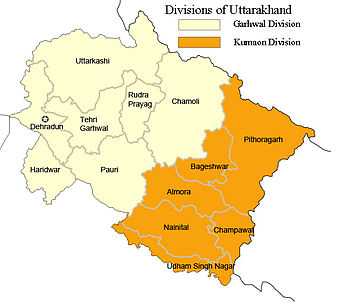
There are 13 districts in Uttarakhand which are grouped into two divisions, Kumaon and Garhwal. Four new districts named Didihat, Ranikhet, Kotdwar, and Yamunotri were declared by then Chief Minister of Uttarakhand, Ramesh Pokhriyal, on 15 August 2011 but yet to be offocially formed.[41]
Districts of two divisions are as follows:
|
Kumaon Division
|
Garhwal Division
|
Each district is governed by a district commissioner or district magistrate. The districts are further divided into sub-divisions, which are governed by sub-divisional magistrates; sub-divisions comprise blocks containing panchayats (village councils) and town municipalities.
According to the 2011 census, Haridwar, Dehradun, and Udham Singh Nagar are the most populous districts, each of them having a population of over one million.[32]
Culture
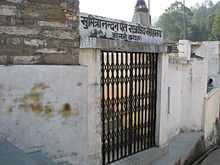
Uttarakhand's diverse ethnicities have created a rich literary tradition in languages including Hindi, Kumaoni, Garhwali, Jaunsari, and Bhoti. Many of its traditional tales originated in the form of lyrical ballads and chanted by itinerant singers and are now considered classics of Hindi literature. Ganga Prasad Vimal, Manohar Shyam Joshi, Prasoon Joshi, Shekhar Joshi, Shailesh Matiyani, Shivani, Sangeet Natak Akademi Awardee Mohan Upreti, B. M. Shah, Sahitya Akademi awardee Manglesh Dabral and Jnanpith awardee Sumitranandan Pant are some major literary figures from the region. Prominent philosopher and environmental activist Sundarlal Bahuguna and Vandana Shiva are also from Uttarakhand.
The dances of the region are connected to life and human existence and exhibit myriad human emotions. Langvir Nritya is a dance form for males that resembles gymnastic movements. Barada Nati folk dance is another famous dance of Dehradun, which is practised during some religious festivals. Other well-known dances include Hurka Baul, Jhora-Chanchri, Jhumaila, Chauphula, and Chholiya.[42] Music is an integral part of the Uttarakhandi culture. Popular types of folk songs include Mangal, Basanti, Khuded and Chhopati.[43] These folk songs are played on instruments including dhol, damau, turri, ransingha, dholki, daur, thali, bhankora, mandan and mashakbaja. "Bedu Pako" is a populor folk song of Uttarakhand with international fame and legendary status within the state. It serves as unofficial state song of Uttarakhand.[44] Music is also used as a medium through which the gods are invoked. Jagar is a form of ghost worship in which the singer, or Jagariya, sings a ballad of the gods, with allusions to great epics, like Mahabharat and Ramayana, that describe the adventures and exploits of the god being invoked. Narendra Singh Negi and Mina Rana are popular folk singers of the region.[45]
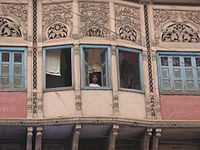
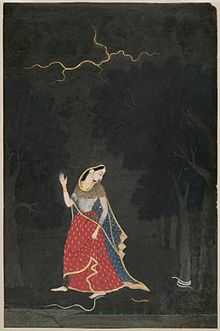
Among the prominent local crafts is wood carving, which appears most frequently in the ornately decorated temples of Uttarakhand. Intricately carved designs of floral patterns, deities, and geometrical motifs also decorate the doors, windows, ceilings, and walls of village houses. Beautifully worked paintings and murals are used to decorate both homes and temples. Pahari painting is a form of painting that flourished in the region between the 17th and 19th century. Mola Ram started the Garhwal Branch of the Kangra school of painting. Guler State was famous as the cradle of Kangra paintings. Kumaoni art often is geometrical in nature, while Garhwali art is known for its closeness to nature. Other crafts of Uttarakhand include handcrafted gold jewellery, basketry from Garhwal, woollen shawls, scarves, and rugs. The latter are mainly produced by the Bhotiyas of northern Uttarakhand.
The primary food of Uttarakhand is vegetables with wheat being a staple, although non-vegetarian food is also served. A distinctive characteristic of Uttarakhand cuisine is the sparing use of tomatoes, milk, and milk based products. Coarse grain with high fibre content is very common in Uttarakhand due to the harsh terrain. Another crop which is associated with Uttarakhand is Buckwheat (locally called Madua or Jhingora), particularly in the interior regions of Kumaon and Garhwal. Generally, either Desi Ghee or Mustard oil is used for the purpose of cooking food. Simple recipes are made interesting with the use of hash seeds "Jakhiya" as spice. Bal Mithai is a popular fudge-like sweet. Other popular dishes include Dubuk, Chains, Kap, Chutkani, Sei, and Gulgula. A regional variation of Kadhi called Jhoi or Jholi is also popular.[46]
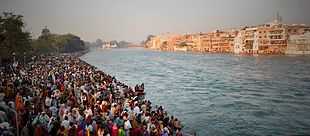
One of the major Hindu pilgrimages, Kumbh Mela, takes place in Uttarakhand. Haridwar is one of the four places in India where this mela is organised. Haridwar most recently hosted the Purna Kumbh Mela from Makar Sankranti (14 January 2010) to Vaishakh Purnima Snan (28 April 2010). Hundreds of foreigners joined Indian pilgrims in the festival which is considered the largest religious gathering in the world.[47] Kumauni Holi, in forms including Baithki Holi, Khari Holi and Mahila Holi, all of which start from Vasant Panchami, are festivals and musical affairs that can last almost a month. Ganga Dashahara, Vasant Panchami, Makar Sankranti, Ghee Sankranti, Khatarua, Vat Savitri, and Phul Dei are other major festivals. In addition, various fairs like Kanwar Yatra, Kandali Festival, Ramman, Harela mela, Nauchandi mela, Uttarayani mela and Nanda Devi Raj Jat Mela take place.
Economy
The Uttarakhand state is the second slowest growing state in India.[48] Its gross state domestic product (GSDP) (at constant prices) more than doubled from ![]() 24,786 crore in FY2005 to
24,786 crore in FY2005 to ![]() 60,898 crore in FY2012. The real GSDP grew at 13.7% (CAGR) during the FY2005–FY2012 period. The contribution of the service sector to the GSDP of Uttarakhand was just over 50% during FY 2012. Per capita income in Uttarakhand is
60,898 crore in FY2012. The real GSDP grew at 13.7% (CAGR) during the FY2005–FY2012 period. The contribution of the service sector to the GSDP of Uttarakhand was just over 50% during FY 2012. Per capita income in Uttarakhand is ![]() 1,03,000 (FY 2013) which is higher than the national average of
1,03,000 (FY 2013) which is higher than the national average of ![]() 74,920 (FY2013).[49][50] According to the Reserve Bank of India, the total foreign direct investment in the state from April 2000 to October 2009 amounted to US$46.7 million.[51]
74,920 (FY2013).[49][50] According to the Reserve Bank of India, the total foreign direct investment in the state from April 2000 to October 2009 amounted to US$46.7 million.[51]
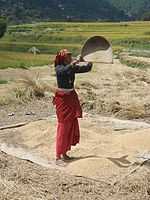
Like most of India, agriculture is one of the most significant sectors of the economy of Uttarakhand. Basmati rice, wheat, soybeans, groundnuts, coarse cereals, pulses, and oil seeds are the most widely grown crops. Fruits like apples, oranges, pears, peaches, litchis, and plums are widely grown and important to the large food processing industry. Agricultural export zones have been set up in the state for leechi, horticulture, herbs, medicinal plants, and basmati rice. During 2010, wheat production was 831 thousand tonnes and rice production was 610 thousand tonnes, while the main cash crop of the state, sugarcane, had a production of 5058 thousand tonnes. As 90% of the state consists of hills, the yield per hectare is not very high. 86% of all croplands are in the plains while the remaining is from the hills.[52]
| Uttarakhand Economy at a Glance[53]
figures in crores of Indian Rupees | |
| Economy at a Glance (FY-2012) | In Indian Rupees |
|---|---|
| GSDP (current) | |
| Per capita income | |
Other key industries include tourism and hydropower, and there is prospective development in IT, ITES, biotechnology, pharmaceuticals and automobile industries. The service sector of Uttarakhand mainly includes tourism, information technology, higher education, and banking.[52]
During 2005–2006, the state successfully developed three Integrated Industrial Estates (IIEs) at Haridwar, Pantnagar, and Sitarganj; Pharma City at Selaqui; Information Technology Park at Sahastradhara (Dehradun); and a growth centre at Siggadi (Kotdwar). Also in 2006, 20 industrial sectors in public private partnership mode were developed in the state.[54]
Flora and fauna
| Animal |
|
|---|---|
| Bird |
|
| Flower |
|
| Tree |
Burans |
Uttarakhand has a great diversity of flora and fauna. It has a recorded forest area of 34651 km2 which constitutes 65% of the total area of the state.[57] Uttarakhand is home to rare species of plants and animals, many of which are protected by sanctuaries and reserves. National parks in Uttarakhand include the Jim Corbett National Park (the oldest national park of India) at Ramnagar in Nainital District, and Valley of Flowers National Park and Nanda Devi National Park in Chamoli District, which together are a UNESCO World Heritage Site. A number of plant species in the valley are internationally threatened, including several that have not been recorded from elsewhere in Uttarakhand.[58] Rajaji National Park in Haridwar District and Govind Pashu Vihar National Park and Sanctuary and Gangotri National Park in Uttarkashi District are some other protected areas in the state.[59]
Leopards are found in areas which are abundant in hills but may also venture into the lowland jungles. Smaller felines include the jungle cat, fishing cat, and leopard cat. Other mammals include four kinds of deer (barking, sambar, hog and chital), sloth and Himalayan black bears, Indian gray mongooses, otters, yellow-throated martens, bharal (goat antelopes), Indian pangolins, and langur and rhesus monkeys. In the summer, elephants can be seen in herds of several hundred. Marsh crocodiles (Crocodylus palustris), gharials (Gavialis gangeticus) and other reptiles are also found in the region. Local crocodiles were saved from extinction by captive breeding programs and subsequently re-released into the Ramganga river.[60] Several freshwater terrapins and turtles like the Indian sawback turtle (Kachuga tecta), brahminy river turtle (Hardella thurgii), and Ganges softshell turtle (Trionyx gangeticus) are found in the rivers. Butterflies and birds of the region include red Helen (Papilio helenus), the great eggfly (Hypolimnos bolina), common tiger (Danaus genutia), pale wanderer (Pareronia avatar avatar), jungle babbler, tawny-bellied babbler, great slaty woodpecker, red-breasted parakeet, orange-breasted green pigeon and chestnut-winged cuckoo.[61]In the year 2011, a rare migratory bird, named Bean Goose, was also seen in the Jim Corbett National Park.[62]
Evergreen oaks, rhododendrons, and conifers predominate in the hills. Shorea robusta (sal), silk cotton tree (Bombax ciliata), Dalbergia sissoo, Mallotus philippensis, Acacia catechu, Bauhinia racemosa, and Bauhinia variegata (camel's foot tree) are some other trees of the region. Albizia chinensis, the sweet sticky flowers of which are favoured by sloth bears, are also part of the region's flora.[61] A decade long study by Prof. C.P. Kala concluded that the Valley of Flowers is endowed with 520 species of higher plants (angiosperms, gymnosperms and pteridophytes), of these 498 are flowering plants. The park has many species of medicinal plants including Dactylorhiza hatagirea, Picrorhiza kurroa, Aconitum violaceum, Polygonatum multiflorum, Fritillaria roylei, and Podophyllum hexandrum.[63][64]
Transport
Uttarakhand has 28,508 km of roads, of which 1,328 km are national highways and 1,543 km are state highways.[54] The State Road Transport Corporation (SRTC), which has been reorganized in Uttarakhand as the Uttarakhand Transport Corporation, is a major constituent of the transportation system in the state. The Corporation began to work on 31 October 2003 and provides services on interstate and nationalized routes. As of 2012, approximately 1000 buses are being plied by the "Uttarakhand Transport Corporation" on 35 nationalized routes along with many other non-nationalized routes. There are also private transport operators operating approximately 3000 buses on non-nationalised routes along with a few interstate routes in Uttarakhand and the neighbouring state of U.P.[65] For travelling locally, the state, like most of the country, has auto rickshaws and cycle rickshaws. In addition, remote towns and villages in the hills are connected to important road junctions and bus routes by a vast network of crowded share jeeps.[66]
The air transport network in the state is gradually improving. Jolly Grant Airport in Dehradun, is the busiest airport in the state with six daily flights to Delhi Airport. Pantnagar Airport, located in Pantnagar of the Kumaon region does not have any commercial air services. There government is planning to develop Naini Saini Airport in Pithoragarh,[67] Bharkot Airport in Chinyalisaur in Uttarkashi district and Gauchar Airport in Gauchar, Chamoli district. There are plans to launch helipad service in Pantnagar and Jolly Grant Airports and other important tourist destinations like Ghangaria and Hemkund Sahib.[68]
As over 80% of Uttarakhand's terrain consists of hills, railway services are very limited in the state and are largely confined to the plains. In 2011, the total length of railway tracks was about 345 km.[54] Rail, being the cheapest mode of transport, is most popular. The most important railway station in Kumaun Division of Uttarakhand is at Kathgodam, 35 kilometres away from Nainital. Kathgodam is the last terminus of the broad gauge line of North East Railways that connects Nainital with Delhi, Dehradun, and Howrah. Other notable railway stations are at Pantnagar, Lalkuan and Haldwani.
Dehradun railway station is a railhead of the Northern Railways.[69] Haridwar station is situated on the Delhi–Dehradun and Howrah–Dehradun railway lines. One of the main railheads of the Northern Railways, Haridwar Junction Railway Station is connected by meter gauge and broad gauge lines. Roorkee comes under Northern Railway region of Indian Railways on the main Punjab – Mughal Sarai trunk route and is connected to major Indian cities. Other railheads are Rishikesh, Kotdwar and Ramnagar linked to Delhi by daily trains.
Tourism

Uttarakhand has many tourist spots due to its location in the Himalayas. There are many ancient temples, forest reserves, national parks, hill stations, and mountain peaks that draw large number of tourists. There are 44 nationally protected monuments in the state.[70] Oak Grove School in the state is on the tentative list for World Heritage Sites.[71] Two of the most holy rivers in Hinduism the Ganges and Yamuna, originate in Uttarakhand.

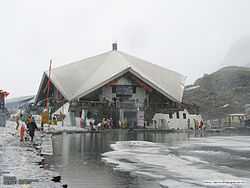
Uttarakhand has long been called "Land of the Gods"[25] as the state has some of the holiest Hindu shrines, and for more than a thousand years, pilgrims have been visiting the region in the hopes of salvation and purification from sin. Gangotri and Yamunotri, the sources of the Ganges and Yamuna, dedicated to Ganga and Yamuna respectively, fall in the upper reaches of the state and together with Badrinath (dedicated to Vishnu) and Kedarnath (dedicated to Shiva) form the Chota Char Dham, one of Hinduism's most spiritual and auspicious pilgrimage circuits. Haridwar, meaning "Gateway to the God", is a prime Hindu destination. Haridwar hosts the Kumbha Mela every twelve years, in which millions of pilgrims take part from all parts of India and the world. Rishikesh near Haridwar is known as the preeminent yoga centre of India. The state has an abundance of temples and shrines, many dedicated to local deities or manifestations of Shiva and Durga, references to many of which can be found in Hindu scriptures and legends.[72] Uttarakhand is, however, a place of pilgrimage not only for the Hindus. Piran Kaliyar Sharif near Roorkee is a pilgrimage site to Muslims, Gurdwara Hemkund Sahib, nested in the Himalayas, is a prime pilgrimage center for the Sikhs. Tibetan Buddhism has also made itself felt with the reconstruction of Mindrolling Monastery and its Buddha Stupa, described as the world's highest at Clement Town, Dehradun.[73][74]
Some of the most famous hill stations in India are in Uttarakhand. Mussoorie, Nainital, Dhanaulti, Lansdowne, Sattal, Almora, Kausani, Bhimtal, and Ranikhet are some popular hill stations in India.[75] The state has 12 National Parks and Wildlife Sanctuaries which cover 13.8 percent of the total area of the state. They are located at different altitudes varying from 800 to 5400 meters. The oldest national park on the Indian sub-continent, Jim Corbett National Park, is a major tourist attraction.[59] The park is famous for its varied wildlife and Project Tiger run by the Government of India. Rajaji National Park is famous for its elephants. In addition, the state boasts Valley of Flowers National Park and Nanda Devi National Park in Chamoli District, which together are a UNESCO World Heritage Site. Vasudhara Falls, near Badrinath is a waterfall with a height of 122 metres (400 ft) set in a backdrop of snow-clad mountains.[76] The state has always been a destination for mountaineering, hiking, and rock climbing in India. A recent development in adventure tourism in the region has been whitewater rafting in Rishikesh. Due to its proximity to the Himalaya ranges, the place is full of hills and mountains and is suitable for trekking, climbing, skiing, camping, rock climbing, and paragliding.[77]Roopkund is a popular trekking site, famous for the mysterious skeletons found in a lake, which was featured by National Geographic Channel in a documentary.[78] The trek to Roopkund passes through the beautiful meadows of Bugyal.
Education
On 30 September 2010 there were 15,331 primary schools with 1,040,139 students and 22,118 working teachers.[79][80][81] At the 2011 census the literacy rate of the state was 79.63% with 88.33% literacy for males and 70.70% literacy for females.[34] The language of instruction in the schools is either English or Hindi. There are mainly government-run, private unaided (no government help), and private aided schools in the state. The main school affiliations are CBSE, CISCE or the state syllabus defined by the Department of Education of the Government of Uttarakhand.
Uttarakhand is also home to a number of universities and degree colleges.
Sports
Adventure Sports, Water Sports and Mountaineering in Uttarakhand are very popular. Tourists and adventure seekers from far and wide come here to experience white water river rafting in Uttarakhand. As Uttarakhand has got some great mountains and peaks where mountaineers love to climb.
Skiing, Ice Skating, Sailing, Parasailing, Kayaking, Canoeing, Rafting, Yachting, Trekking, Rock Climbing, Hiking, Paragliding, Sky Diving and Bungee jumping also serve as another interesting sport's activity for tourists in Uttarakhand.[82]
The mountain rivers in the state offer some great opportunities for adventure seekers to enjoy Sailing and Para Sailing in Uttarakhand.
Golf is another sports which has a newly found love of the tourists in Uttarakhand specially places like Ranikhet is serving as an attractive destination for golfers in Uttarakhand.
Uttarakhand Cricket Association is the governing body of the Cricket activities in the Uttarakhand state of India and the Uttarakhand Cricket Team.
Uttarakhand State Football Association is the governing body of Association Football in Uttarakhand and Uttarakhand football team represents Uttarakhand in Santosh Trophy & other club league.
Sports Stadiums
This is a list of stadiums in Uttarakhand:[83]
- Abhimanyu Cricket Academy – Dehradun
 Abhimanyu Cricket Academy, Dehradun
Abhimanyu Cricket Academy, Dehradun
- Ambedkar Stadium – Dehradun
- Nainital Stadium (commonly known as "Flats") – Nainital
- Somnath Stadium – Ranikhet
- Jeewan Chandra Upadhyaya Stadium – Pithoragarh
- Mini Stadium (under construction) – Dehradun
- Mini Stadium (under construction) – Kaladhungi
- Indira Gandhi International Sports Complex (under construction) – Haldwani
- Rajiv Gandhi International Cricket Stadium, Dehradun (under construction) – Dehradun
- Sports Stadium, Udham Singh Nagar – Rudrapur
- Stevenson Stadium – Pantnagar
Notable People
See also
| Wikinews has related news: Uttarakhand |
|
Kumaon
|
References
- ↑ "Inequality- adjusted Human Development Index for India’s States-2011" (PDF). United Nations Development Programme. Retrieved 17 July 2012.
- ↑ "Define Uttarakhand at Dictionary.com". Dictionary.com. Retrieved 27 August 2013.
- ↑ Oxford Dictionaries Online
- ↑ "About Us". Government of Uttarakhand. Retrieved 17 July 2012.
- ↑ 5.0 5.1 Kandari, O. P., & Gusain, O. P. (Eds.). (2001). Garhwal Himalaya: Nature, Culture & Society. Srinagar, Garhwal: Transmedia.
- ↑ Negi, B. (2001). "Round One to the Lobbyists, Politicians and Bureaucrats." The Indian Express, 2 January.
- ↑ "Uttaranchal becomes Uttarakhand". UNI. The Tribune (India). 13 October 2006. Retrieved 22 January 2013.
- ↑ Chopra, Jasi Kiran (2 January 2007). "Uttaranchal is Uttarakhand, BJP cries foul". TNN. The Time of India. Retrieved 22 January 2013.
- ↑ 9.0 9.1 9.2 "Uttarakhand". Encyclopædia Britannica, Inc. Retrieved 17 July 2012.
- ↑ Subhash, Kak. "The Mahabharata as an encyclopaedia" (PDF). Louisiana State University. Retrieved 5 August 2012.
- ↑ Saklani, D. P. (1998). Ancient communities of the Himalaya. New Delhi: Indus Pub. Co.
- ↑ Pande, B. D. (1993). History of Kumaun: English version of "Kumaun Ka Itihas". Almora, U.P., India: Shyam Prakashan: Shree Almora Book Depot.
- ↑ Rawat, A. S. (1989). History of Garhwal, 1358–1947: an erstwhile kingdom in the Himalayas. New Delhi: Indus Pub. Co.
- ↑ Saklani, A. (1987). The history of a Himalayan princely state: change, conflicts and awakening: an interpretative history of princely state of Tehri Garhwal, U.P., A.D. 1815 to 1949 A.D. (1st ed.). Delhi: Durga Publications.
- ↑ Aggarwal, J. C., Agrawal, S. P., & Gupta, S. S. (Eds.). (1995). Uttarakhand: past, present, and future. New Delhi: Concept Pub. Co.
- ↑ Kumar, P. (2000). The Uttarakhand Movement: Construction of a Regional Identity. New Delhi: Kanishka Publishers.
- ↑ "HC quashes CBI report on Rampur Tiraha firing". The Times of India. 2003-07-31. Retrieved 28 July 2012.
- ↑ Reorganisation Bill passed by UP Govt The Indian Express, 24 September 1998.
- ↑ Sengupta, Amit. "Chipko! Hill conservationists". tehelka.com. Retrieved 29 July 2012.
- ↑ Guha, R. (2000). The unquiet woods: ecological change and peasant resistance in the Himalaya (Expanded ed.). Berkeley, Calif.: University of California Press.
- ↑ Hijacking Chipko Political ecology: a critical introduction, by Paul Robbins. Published by Wiley-Blackwell, 2004. ISBN 1-4051-0266-7. Page 194.
- ↑ Agarwal, Anil. "The Chipko Movement". india-today.com. Retrieved 29 July 2012.
- ↑ Mishra, A., & Tripathi, (1978). Chipko movement: Uttaranchal women's bid to save forest wealth. New Delhi: People's Action/Gandhi Book House.
- ↑ "Chipko Movement, India". International Institute for Sustainable Development. Retrieved 29 July 2012.
- ↑ 25.0 25.1 25.2 "Info about Uttarakhand". Nainital Tours & Package. Retrieved 20 December 2012.
- ↑ Kala, C.P. 2012. How Valley of Flowers Got World Heritage Site Tag. Down to Earth. http://www.downtoearth.org.in/content/how-valley-flowers-got-world-heritage-site-tag
- ↑ Sinha, Govind Narayan (September 2006). British India's Forestry and Modern Environmentalism. Itanagar: State Forest Research Institute, Department of Environment & Forests, Government of Arunachal Pradesh Publication No. 22 – General.
- ↑ Negi, S. S. (1991). Himalayan rivers, lakes, and glaciers. New Delhi: Indus Pub. Co.
- ↑ Negi, S. S. (1995). Uttarakhand: land and people. New Delhi: MD Pub.
- ↑ "Census of India – Sociocultural aspects". Government of India, Ministry of Home Affairs. Retrieved 11 November 2013.
- ↑ "Census 2011: Assam records highest rise in Muslim population".
- ↑ 32.0 32.1 "Census of India-2011 (Uttarakhand)" (PDF) (in Hindi). Office of the Registrar General and Census Commissioner, India (ORGI). Retrieved 17 July 2012.
- ↑ "Provisional Population Totals (Uttarakhand)" (PDF). Office of the Registrar General and Census Commissioner, India (ORGI). Retrieved 17 July 2012.
- ↑ 34.0 34.1 34.2 34.3 34.4 "Demography". Government of Uttarakhand. Retrieved 17 July 2012.
- ↑ "Annual Health Survey 2010–2011 Fact Sheet" (PDF). Govt. of India. Retrieved 17 July 2012.
- ↑ "Brahmins In India". Outlook (magazine). 4 June 2007. Retrieved 17 July 2012.
- ↑ Trivedi, Anupam (19 January 2010). "Sanskrit is second official language in Uttarakhand". Hindustan Times. Retrieved 29 July 2012.
- ↑ 38.0 38.1 "Uttarakhand Legislative Assembly". legislativebodiesinindia.nic.in. Retrieved 3 July 2012.
- ↑ "Our Parliament". Parliamentofindia.nic.in. Retrieved 3 July 2012.
- ↑ "Hon'ble Chief Justice". Uttarakhand High Court. Retrieved 3 July 2012.
- ↑ "Uttarakhand CM announces four new districts". Zee News. Retrieved 1 July 2012.
- ↑ "Folk Dances Of North India". culturalindia.net. Retrieved 29 July 2012.
- ↑ "Folk Songs of Uttarakhand". aboututtarakhand.com. Retrieved 29 July 2012.
- ↑ "Bedu Pako".
- ↑ "Dylan of hills singes CM". The Telegraph. 30 January 2007. Retrieved 29 July 2012.
- ↑ Subodh Upadhyay, An Essence of Himalaya, a book about Uttarakhand cuisine
- ↑ , The Independent, 14 April 2010
- ↑ http://indianexpress.com/article/business/business-others/madhya-pradesh-now-fastest-growing-state-uttarakhand-pips-bihar-to-reach-second/
- ↑ http://indiatoday.intoday.in/story/uttarakhand-macro-economy-economics-and-statistics-department/1/398361.html
- ↑ http://business-standard.com/article/economy-policy/uttarakhand-per-capita-income-rises-to-rs-1-03-lakh-114071101356_1.html
- ↑ "Uttarakhand" (PDF). India Brand Equity Foundation. Retrieved 17 July 2012.
- ↑ 52.0 52.1 "Uttarakhand: The State Profile" (PDF). PHD Chamber of Commerce and Industry. Retrieved 17 July 2012.
- ↑ "Uttarakhand Economy at a Glance". State Domestic Product and other aggregates (2004–05 series). Ministry of Statistics and Programme Implementation. 1 August 2012. Retrieved 1 August 2012.
- ↑ 54.0 54.1 54.2 "Uttaranchal". Government of India. Retrieved 29 July 2012.
- ↑ "State Symbols of Uttarakhand". gmvnl-Garhwal mandal vikas nigam limited. Retrieved 1 April 2012.
- ↑ "Uttarakhand State Signs | Uttarakhand State Tree". uttaraguide.com. 2012. Retrieved 8 October 2012.
State Flower : Brahm Kamal
- ↑ "Uttarakhand Annual Plan 2011–12 Finalisation Meeting Between Hon'ble Dputy Chairman, Planning Commission & Hon’ble Chief Minister, Uttarakhand" (PDF). planningcommission.nic.in. Retrieved 3 July 2012.
- ↑ "Nanda Devi and Valley of Flowers National Parks". UNESCO. Retrieved 3 July 2012.
- ↑ 59.0 59.1 "Wildlife Eco-Tourism In Uttarakhand" (PDF). uttarakhandforest.org. Retrieved 14 July 2012.
- ↑ Riley, Laura; William Riley (2005):208. Nature's Strongholds: The World's Great Wildlife Reserves. Princeton University Press. ISBN 0-691-12219-9.
- ↑ 61.0 61.1 K. P. Sharma (1998). Garhwal & Kumaon: A Guide for Trekkers and Tourists. Cicerone Press Limited. pp. 56–. ISBN 978-1-85284-264-2. Retrieved 9 July 2012.
- ↑ "A Rare Visit of Ben Goose at Corbett". corbett-national-park.com. Retrieved 15 April 2015.
- ↑ Kala, C.P. 2005. The Valley of Flowers; A newly declared World Heritage Site. Current Science, 89 (6): 919–920.
- ↑ Kala, C.P. 2004. The Valley of Flowers; Myth and Reality. International Book Distributors, Dehradun, India
- ↑ "Historical Information". Government of Uttarakhand. Retrieved 29 July 2012.
- ↑ "Uttarakhand Getting there & around". lonelyplanet.com. Retrieved 29 July 2012.
- ↑ "Govt seeks Rs 25 cr from Centre for Naini-Saini airport". Business Standard. 12 December 2012. Retrieved 7 August 2014.
- ↑ "Airports in Uttarakhand". uttaranchal-india.com. Retrieved 29 July 2012.
- ↑ "Dehradun Railway Station". euttaranchal.com. Retrieved 29 July 2012.
- ↑ "Alphabetical List of Monuments — Uttarakhand". Archaeological Survey of India. Retrieved 29 July 2012.
- ↑ "Tentative Lists". UNESCO. Retrieved 29 July 2012.
- ↑ Dilwali, A., & Pant, P. (1987). The Garhwal Himalayas, ramparts of heaven. New Delhi: Lustre Press.
- ↑ "Mindrolling Monastery". lonelyplanet.com. Retrieved 29 July 2012.
- ↑ "Dalai Lama Consecrates Stupa at Mindroling Monastery". Voice of America Tibetan. Retrieved 29 July 2012.
- ↑ "Places in Uttarakhand (Uttaranchal)". lonelyplanet.com. Retrieved 29 July 2012.
- ↑ Bisht, Harshwanti (1994). Tourism in Garhwal Himalaya : with special reference to mountaineering and trekking in Uttarkashi and Chamoli Districts. New Delhi: Indus Pub. Co. pp. 41, 43. ISBN 9788173870064.
- ↑ "Destination for Adventure Sports". mapsofindia.com. Retrieved 29 July 2012.
- ↑ "Riddles of the Dead". National Geographic. Retrieved 29 July 2012.
- ↑ "Primary schools in Uttarakhand as of 30 September 2010" (PDF) (in Hindi). Government of Uttarakhand. Retrieved 18 July 2012.
- ↑ "Enrollment of (General) Children in Primary School" (PDF). Government of Uttarakhand. Retrieved 17 July 2012.
- ↑ "Status of teachers (districtwise) as of 30 September 2010" (PDF). Government of Uttarakhand. Retrieved 17 July 2012.
- ↑ Nation’s biggest ice-skating rink draws players from across country
- ↑ /About/Sports/stadiums.html UttarakhandOnline
Further reading
- Rivett-Carnac, J. H. (1879). Archaeological notes on ancient sculpturings on rocks in Kumaon, India. Calcutta : G.H. Rouse.
- Upreti, Ganga Dutt (1894). Proverbs & folklore of Kumaun and Garhwal. Lodiana Mission Press.
- Oakley, E Sherman (1905). Holy Himalaya; the religion, traditions, and scenery of Himalayan province (Kumaon and Garwhal). Oliphant Anderson & Ferrier, London.
- of Kumaon, Raja Rudradeva; (Ed. with English tr. Haraprasada Shastri) (1910). Syanika sastra: or A Book on Hawking. Asiatic Society, Calcutta.
- Umachand Handa (2002). History of Uttaranchal. Indus Publishing. ISBN 81-7387-134-5.
- Husain, Z. (1995). Uttarakhand movement: the politics of identity and frustration, a psycho-analytical study of the separate state movement, 1815–1995. Bareilly: Prakash Book Depot. ISBN 81-85897-17-4
- Śarmā, D. (1989). Tibeto-Himalayan languages of Uttarakhand. Studies in Tibeto-Himalayan languages, 3. New Delhi, India: Mittal Publications. ISBN 81-7099-171-4
- Fonia, K. S. (1987). Uttarakhand, the land of jungles, temples, and snows. New Delhi, India: Lancer Books.
- Mukhopadhyay, R. (1987). Uttarakhand movement a sociological analysis. Centre for Himalayan Studies special lecture, 8. Raja Rammohunpur, Dt. Darjeeling: University of North Bengal.
- Uma Prasad Thapliyal (2005). Uttaranchal: Historical and cultural perspectives. B.R. Pub. Corp., ISBN 81-7646-463-5.
- Vijaypal Singh Negi, Jawahernagar, Post-Agastyamuni,Dist.-Rudraprayag, The Great Himalays 1998,
External links
- Government
- Official website of Uttarakhand government
- Official website of Uttarakhand Tourism Development Board
- Other
- Uttarakhand at DMOZ
- Resources on Uttarakhand – news, policies, documents, articles
- Photos of the massive destruction due to floods, Uttarakhand
 |
Himachal Pradesh | |
 | |
| Haryana | |
|||
| ||||
| | ||||
| Uttar Pradesh | Far-Western Region, |
| ||||||||||||||||||||||||||
| |||||||||||||||||
| ||||||||||||||
| ||||||||||
| ||||||||||||||||||||||||||||||||||||||||||||||||||





